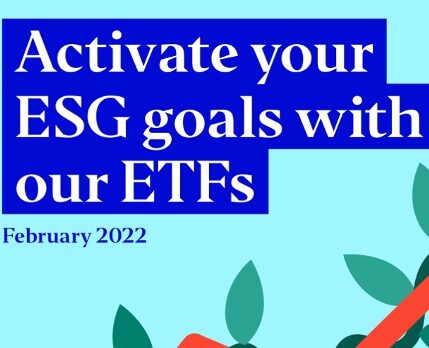

The ability for investors to influence corporate behaviour comes down to the power the funds they invest in have over company boards. Active funds took the early lead in the environmental, social and governance (ESG) fund sector but the rapid development of ESG exchange-traded funds (ETFs) means they are set to become a significant force.
Global ESG assets surpassed $35trn in 2020 and are on track to exceed $50trn by 2025, when they would account for more than a third of all fund assets, according to Bloomberg Intelligence. ESG ETFs are among the fastest-growing components and are on track to exceed $1trn by 2025. This has led to a proliferation of products, targeted at a widening investor base.
All ESG funds exclude controversial sectors, such as thermal coal, and channel capital into sustainable businesses, collectively bolstering standards and innovation. “Investing in a clean energy ETF helps to support the technologies that improve energy efficiency,” says Chris Mellor, head of EMEA ETF equity and commodity product management at Invesco.
Beyond these basic characteristics, the main distinction between funds concerns their ability to exclude and engage. Funds can exclude low ESG stocks and passively invest in the remaining high ESG stocks, invest more widely and engage with the aim of improving ESG, or combine these approaches.
There are a variety of approaches to ESG. Some investors are attracted to funds that take the heavily targeted approach of impact investment, while others prefer those with the more relaxed criteria of sustainable investment.
In its early development, the sector was dominated by socially responsible investment (SRI) index products designed to appeal to heavily committed investors. The more recent wave of investors is “less dyed-in-the-wool”, according to Mellor. “These investors find SRI too extreme. They can’t accept the volatility or tracking error.”
By contrast, sustainable investment funds, such as those based on MSCI ESG Universal Select Business Screens (USBS) indices, remain more widely invested while rebalancing to increase relative exposure to companies with strong profiles. Helpfully, this approach is likely to enhance stewardship.
ETF structures
All passive funds track an underlying index. Allocations are determined by its rules, rather than the fund manager. Active managers can threaten to divest if their concerns are not met; without additional leverage, passive fund managers lack a credible sanction. The choice of ESG index is therefore critical.
USBS excludes low-ESG-score stocks but is designed to maintain wide exposure. “Typically, exclusions are 10-30%, depending on the benchmark,” says Mellor. The remaining stocks are weighted by market capitalisation multiplied by ESG scores and ESG score momentum.
“There’s a degree to which you kick some out – but engagement is as important as excluding offenders,” says Mellor. While USBS punishes bad behaviour by reducing relative allocations to assets with poor ESG performance, investors “still have a seat at the table, the right to vote and a voice that needs to be heard”.
“Once you divest, you have no say in how the company behaves – they don’t have to listen,” he says. “A company that is not quite behaving badly enough would remain included. But ultimately, if the company does not engage and respond, it’s going to score badly and get kicked out.”
Unintended consequences
As ESG ETFs stock allocations deviate from the broad market, they do not exactly replicate its performance. It means there is some degree of so-called tracking error, which can be positive or negative for returns. “It’s just that this is defined not by the portfolio managers but by the index provider’s criteria. There’s an active element in any fund that deviates from the broad market,” says Mellor.
There’s a clear relationship between fund ESG scores and the deviation from market allocations required to deliver them. SRI requires MSCI ESG ratings of A or above (ratings go down to CCC), which excludes a broad swathe of the market. “SRI strategies achieve 40-50% ESG score improvement versus the world benchmark – but they’re taking 2.5% tracking error,” says Mellor, noting this is higher in emerging markets. “By contrast, USBS indices have lower tracking error but still meaningful ESG score improvements.”
SRI exclusions mean performance is driven less by ESG and more by unintended consequences, according to Mellor. “Being very underweight in energy – typical of SRI strategies – means the fund will underperform when energy outperforms.”
Likewise, SRI emerging markets fund performance was “pretty terrible” in 2020 despite high ESG companies outperforming. This was because they tend to underweight China, and China was outperforming while other emerging markets struggled with Covid-19. “That is often a risk,” he says. “You need to understand what you’re getting into and the exposures you’re accepting, intended or otherwise.”
The investor’s choice of fund type depends on whether they have uncrossable red lines. “You must accept the risks that come with exclusion. If you are willing to stay invested and engaged, you can both improve ESG and control risk. You can’t control them 100%, but it’s nowhere near the more extreme SRI solution,” says Mellor.
Empowering stewardship
The traditional drawback of passive funds has been that their lower fees result in fewer resources for engagement. But if the wider fund group manages a substantial volume of assets, especially if spread across active and passive funds, this effect can be negated.
Invesco manages $1.5trn including 75% in active funds. “We also have a bespoke proxy voting system that ensures we don’t blindly follow the advice of proxy voting service providers,” says Mellor. “We overlay their services with our own approach, especially on controversial matters.”
Smaller passive managers are unlikely to offer the same level of stewardship. “It’s very difficult to disassociate engagement and active ownership from ESG. Engagement and voting power are the ways to drive change. It’s difficult to claim a product is ESG while not engaging,” he says.
Climate investment
Cop26 focused the world on climate investments. “It made it clear that investors and companies have to step up. We’re increasingly going to see a combination of ESG and Paris-aligned funds,” Mellor says. “We’re also hearing a lot more about biodiversity. It wouldn’t surprise me if we started seeing more biodiversity products.”
This begs the question of how great a burden ESG ETFs can carry. “How many things can we align with? In some cases, it becomes impossible. You can’t create an index that meets SRI levels of ESG while achieving the Paris alignment – you would not have enough stocks left for a diversified portfolio.”
Funds that do not pay due attention to sustainability are becoming un-investable for a large swathe of investors. The emergence of ESG ETFs – especially those that remain broadly invested and are backed by substantial assets under management – has provided investors with a powerful low-cost option to improve corporate behaviour.
Learn more about finding the right balance between performance and ESG objectives, and creating core ESG ETFs that are fit for purpose, in ‘Activate your ESG goals with our ETFs’.
Risk warnings
The value of investments and any income will fluctuate (this may partly be the result of exchange rate fluctuations) and investors may not get back the full amount invested.
Important information
This is marketing material and not intended as a recommendation to buy or sell any particular asset class, security or strategy. Regulatory requirements that require impartiality of investment/investment strategy recommendations are therefore not applicable nor are any prohibitions to trade before publication.
By accepting this material, you consent to communicate with us in English, unless you inform us otherwise.
Where individuals or the business have expressed opinions, they are based on current market conditions, they may differ from those of other investment professionals, they are subject to change without notice and are not to be construed as investment advice.







